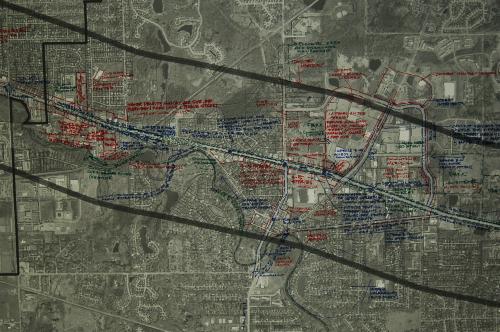Design charrette creates Lansing to Webberville corridor improvements
The Vision Charrette for Michigan/Grand River Avenues, from the Lansing Capitol to Webberville, is an example of a Michigan region using this process to enhance a highway corridor.
One of the more intense tools to engage a large number of people in a government planning process and accomplish a great deal of planning work in a relatively short period of time is a charrette. In Michigan the most recent example is the Vision Charrette for Michigan Avenue/Grand River Avenue, from the Lansing Capitol to Webberville.
But first a little more about a charrette, like what it is. Today it is the popular name given to an intense process to engage the public to address a community’s development challenges. The process is done quickly with work done under very short deadlines. The name comes from France, when architect students were under deadline to get their projects turned in. So much pressure that the students would ride through Paris on a small cart that was taking their drawings to the professor. Those students were often putting finishing touches on their work while riding on the cart. The small cart is called a charrette in French.
For more about charrettes visit the national Cooperative Extension resource Charrette use in the Planning Process (part of the Public Participation in Planning section) or the National Charrette Institute, which provides training on conducting charrettes and other resources.
The Michigan Avenue/Grand River Avenue Vision Charrette is part of a Mid-Michigan Program for Greater Sustainability. The program covers Lansing, East Lansing, Meridian Township, Williamstown Township, Williamston, Leroy Township and the Village of Webberville. There is a variety of communities, from urban, small town, residential neighborhoods, Michigan State University (MSU), agricultural, and rural areas. The purpose is to find consensus on plans for transportation, urban design, land planning, and economic development to be done during the next 20 years.
A team of land use educators from Michigan State University Extension took part in extensive training through the National Charrette Institute and MiPlace Partnership Initiative. The Extension educators can now provide charrette training as part of the MiPlace curriculum and assist local governments in pursuing similar projects.
Those MSU Extension educators were part of the team that provided facilitation at the Vision Charrette’s opening event held May 1. The next day, the Charrette team took the information from the opening event and then started meeting with groups that focused on various technical aspects of planning for the corridor. Those technical meetings continued for three days and included topics such as state government issues, transportation, cultural arts, MSU, environment, economic development, housing, energy, and included organizations such as the corridor improvement authority, developers, and local planners.
An example of a compilation of ideas and discussion from the May 1, 2013 Opening Event for part of Meridian Township. These ideas were further evaluated, refined, and prioritized before becoming a part of the final work-in-progress presentation May 7, 2013.
On May 5 an evening open house was held to report preliminary results and ideas. The purpose is to create a feedback loop. The team listened at the opening event and at subsequent technical meetings and then reported back to the larger group. Participants then can offer corrections, modifications as well make decisions. The team then goes back to work and on May 7 a final “work-in-progress” presentation was delivered. Again the public hears what the team believes was the consensus and that consensus is further refined. Throughout this entire process (May 1-7) members of the public were invited to visit the team’s studio in a vacant storefront in East Lansing to talk to members of the team, see work in progress, and watch as ideas unfold.
The team for this Charrette was organized by the Tri-County Regional Planning Commission. They brought in leading national experts, drawing from staff at the National Charrette Institute; Dover, Kohl & Partners Town Planning of Coral Gables, Fla.; and local consultants from Mead & Hunt’s Lansing office.
This charrette is the first of two scheduled for this project. The purpose of the May 1-7 charrette was to develop a unified vision for the entire Michigan/Grand Avenue corridor, as well as identifying three smaller areas for further study. The fall 2013 Charrette will develop more detailed plans for three sub-areas.
For additional information:



 Print
Print Email
Email



